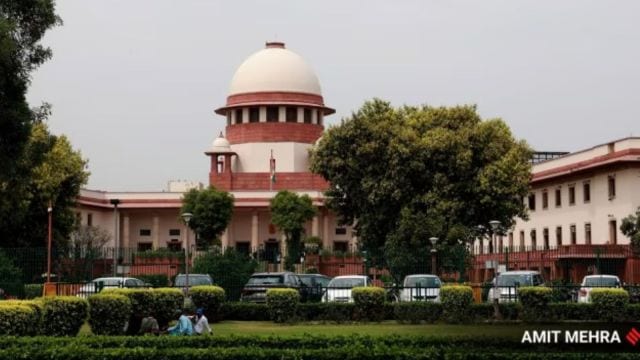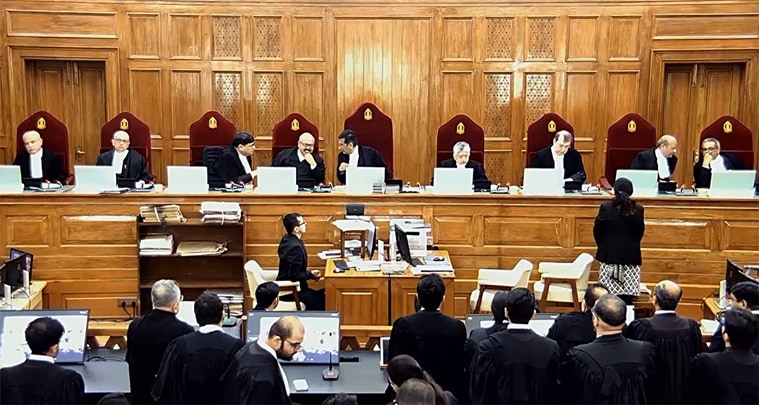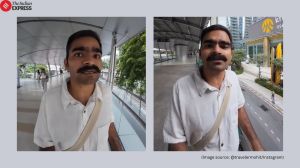IN A landmark ruling that has implications on the citizen’s right to hold property, a nine-judge bench of the Supreme Court Tuesday ruled that not all private property can be deemed “material resource of the community” for redistribution under Article 39(b) of the Constitution.

Chief Justice of India D Y Chandrachud wrote the majority ruling for himself, and Justices Hrishikesh Roy, J B Pardiwala, Manoj Misra, Rajesh Bindal, Satish Chandra Sharma and Augustine George Masih. Justice B V Nagarathna partially disagreed with the majority judgment while Justice Sudhanshu Dhulia dissented.
CJI Chandrachud is set to retire November 9.
Story continues below this ad
The ruling in the constitutional reference essentially undoes several decades of Supreme Court jurisprudence on the issue. A line of judgments holding that both public and private resources fell within the ambit of “material resources of the community” under Article 39(b) stem from a minority opinion by Justice V R Krishna Iyer in State of Karnataka v Shri Ranganatha Reddy (1977).
A 1982 five-judge constitution bench ruling, authored by Justice O Chinnappa Reddy in the case Sanjeev Coke Manufacturing Company vs Bharat Coking Coal Ltd, had affirmed Justice Iyer’s view.
 The nine-Judge bench: (from left) Justices Satish Chandra Sharma, Manoj Misra, Sudhanshu Dhulia, Hrishikesh Roy, Chief Justice of India D Y Chandrachud, Justices B V Nagarathna, J B Pardiwala, Rajesh Bindal and Augustine George Masih.
The nine-Judge bench: (from left) Justices Satish Chandra Sharma, Manoj Misra, Sudhanshu Dhulia, Hrishikesh Roy, Chief Justice of India D Y Chandrachud, Justices B V Nagarathna, J B Pardiwala, Rajesh Bindal and Augustine George Masih.
The majority opinion of the SC has now disagreed with these judgments. It said Justice Iyer “cast the net wide, holding that all resources which meet material needs are covered by the phrase, and any attempts by the government to nationalize these resources would be within the scope of Article 39(b)”.
Falling under Part IV of the Constitution titled “Directive Principles of State Policy” (DPSP), Article 39(b) places an obligation on the state to create policy towards securing “the ownership and control of the material resources of the community are so distributed as best to subserve the common good”. DPSP are meant to be guiding principles for the enactment of laws, but are not directly enforceable in any court of law.
Story continues below this ad
The majority was of the view that Justice Iyer’s “interpretation amounts to endorsing a particular economic ideology. To declare that Article 39(b) includes the distribution of all private resources amounts to endorsing a particular economic ideology and structure for our economy”. It said that Iyer’s judgment followed in Sanjeev Coke “was influenced by a particular school of economic thought”.
It added, “In essence, the interpretation of Article 39(b) adopted in these judgments is rooted in a particular economic ideology and the belief that an economic structure which prioritises the acquisition of private property by the state is beneficial for the nation.”
Justice Nagarathna, in a separate judgment, concurred with the majority view on what constitutes material resource of the community. She underlined the need for a “flexible interpretation”, as per changing times, to an “an organic text” as the Constitution of India. “Neither can there be canonisation of the socialist policy followed by the State nor can the principles akin to laissez faire economics be ignored at a time when they have been resurrected by the State itself to suit the developments of the economy in the Country and for the benefit of the people of India.”
Justice Nagarathna, however, disagreed with the majority view on the interpretation by Justices Krishna Iyer and Chinnappa Reddy and said: “The observations of the Judges in those decisions would not call for any critique in the present times. Neither is it justified nor warranted.”
Story continues below this ad
In his dissenting judgment, Justice Dhulia said that “the broad and inclusive” meaning given to “material resources of the community” by Justice Iyer and Justice Reddy “has stood us in good stead and has lost none of its relevance, or jurisprudential value, nor has it lost the audience which appreciates these values”.
The majority judgment said that interpreting Article 39(b) to place all private property within the ambit of “material resources of the community”, only satisfies one of the three requirements of the phrase — that the goods in question must be a “resource”. However, it ignores the qualifiers that they must be “material” and of the “community”.
The bench underlined: “The use of the words material and community are not meaningless superfluities…The words of the community must be understood as distinct from the individual.”
In fact, if Article 39(b) was meant to include all resources owned by an individual, the court said, it would state that the ownership and control of resources is so disputed as best to subserve the common good.
Story continues below this ad
Similarly, if the provision were to exclude privately owned resources, it would state “ownership and control of resources of the state…” instead of its current phrasing. “They use the words ‘of the community’ rather than of the state… indicates a specific intention to include some privately owned resources. In essence, the text of the provision indicates that not all privately owned resources fall within the ambit of the place. However, privately owned resources are not excluded as a class, and some private resources may be covered.”
The court added that the Ranganath Reddy and Sanjeev Coke judgments “are incorrect to the extent that they hold that all resources of an individual are part of the community, and thus all private property is covered by the phrase material resources of the community”.
The majority view also cited B R Ambedkar’s view that “if the Constitution laid down a particular form of economic and social organisation, it would amount to taking away the liberty of people to decide the social organisation in which they wish to live…”. Citing this, the ruling framed the court’s role “not to lay down economic policy, but to facilitate this intent of the framers to lay down the foundation for an ‘economic democracy’.”
The SC added: “Indeed, it is this spirit and its all-encompassing nature of the constitution, which has allowed elected governments since independence to pursue economic reforms and policies based on domestic conditions, international requirements, and political exigencies of the time”.
Story continues below this ad
The majority opinion referred to India’s economic growth trajectory — the mixed economy of the 1950-60s that included heavy industries and import substitution; the shift towards purportedly “socialist reforms” in the late 1960s and 90s, followed by “market-based reforms” in the 1990s or the “liberalisation years”.
This arc, the court said, reveals Justice Iyer’s “doctrinal error”, in postulating a “rigid” economic theory. And how the “constitution and the custodians of the constitution, the electorate, have routinely rejected one economic dogma as being the exclusive repository of truth”.
The court said that “as participants in a vibrant, multiparty economic democracy, the people of India have voted to power governments which have adopted varied economic and social policies based on the country’s evolving development strategies and challenges. The foresight vision of our framers to establish an economic democracy and trust the wisdom of the elected government has been the backbone of the high growth rate of India’s economy, making it one of the fastest growing economies in the world.”
It added that “to scuttle this constitutional vision by imposing a single economic theory, which views the acquisition of private property by the state as the ultimate goal, would undermine the very fabric and principles of our constitutional framework”.



 The nine-Judge bench: (from left) Justices Satish Chandra Sharma, Manoj Misra, Sudhanshu Dhulia, Hrishikesh Roy, Chief Justice of India D Y Chandrachud, Justices B V Nagarathna, J B Pardiwala, Rajesh Bindal and Augustine George Masih.
The nine-Judge bench: (from left) Justices Satish Chandra Sharma, Manoj Misra, Sudhanshu Dhulia, Hrishikesh Roy, Chief Justice of India D Y Chandrachud, Justices B V Nagarathna, J B Pardiwala, Rajesh Bindal and Augustine George Masih.





